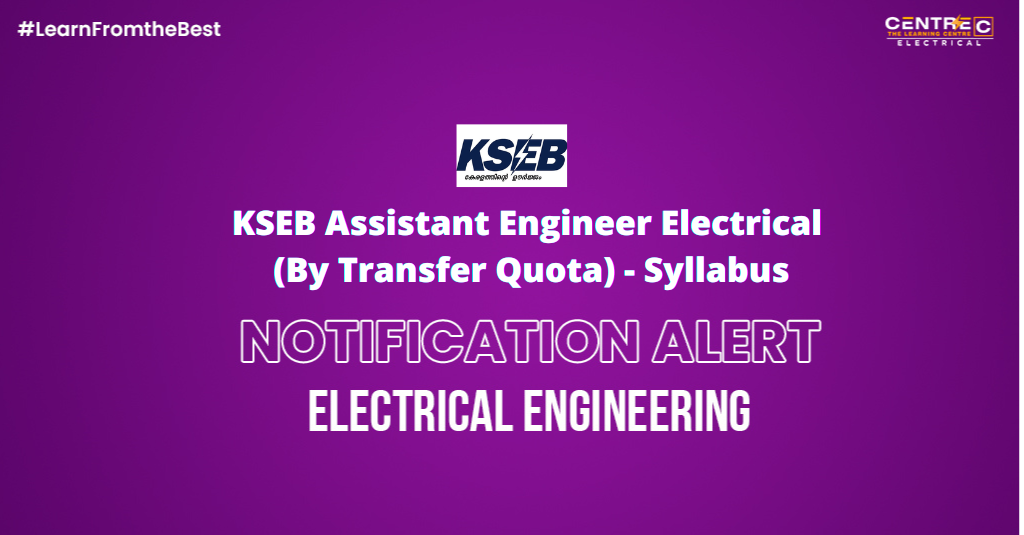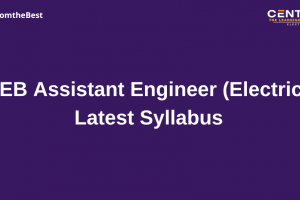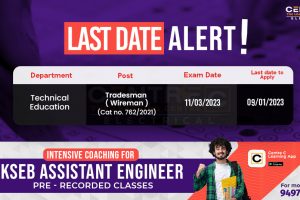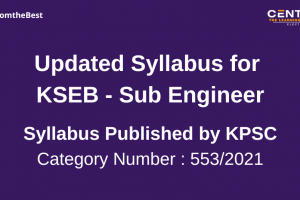
KSEB Assistant Engineer Electrical (By Transfer Quota) – Syllabus
CENTRE-C ELECTRICAL
KSEB Assistant Engineer Electrical (By Transfer Quota) – Syllabus
DETAILED SYLLABUS FOR THE POST OF ASSISTANT ENGINEER (ELECTRICAL) IN KERALA STATE ELECTRICITY BOARD LIMITED (BY TRANSFER QUOTA) (Cat.No.: 006/2021)

Main Topics:-
Part I : Electrical Engineering (Degree Level) – 50 Marks
Part II : Electronics & Communication Engineering (Degree Level) – 50 Marks
Maximum Marks : 100
Duration : 1 Hour 30 Minutes
Medium of Question : English
Mode of Exam : OMR/ONLINE (Objective Multiple Choice)
Part I : ELECTRICAL ENGINEERING (50 Marks)
Electric circuits (10 marks)
- Kirchoff’s laws – maximum power transfer theorem. Star/delta transformation. Energy stored in a capacitor and inductor.
- Analysis of coupled circuits – dot polarity convention – sinusoidal steady state analysis of coupled circuits.
- Generation of alternating voltages and currents – rms value, average value, peak factor, form factor. AC through series R, L, C circuit – series resonance- resonant power –bandwidth. Resonance in parallel circuits.
- Network Graph, KCL, KVL, node and mesh analysis, Transient Response of DC and AC Networks, Sinusoidal steady state analysis, Resonance, Basic Filter concept, Ideal Current and Voltage Sources, Thevenin’s, Norton’s Superposition and Maximum Power Transfer Theorems, Two Port Network, Three Phase Circuits

DC generators (10 marks)
- Constructional details, working principle – types of dc generators – emf equation –power stages – condition for maximum efficiency.
- DC motor – armature control and field control. Single phase transformer – working principle, equivalent circuit, losses in a transformer, condition for maximum efficiency.
- Three phase transformer– construction- difference between power transformer and distribution transformer.
- Three Phase Induction Motors – Principles, Types, Performance characteristics, Starting and Speed Control : Single Phase Induction Motors, Synchronous Machines – Performance, Regulation and Parallel Operation of Generators, Motor Starting, Characteristics and Applications , Servo and Stepper Motors.
Electrical Machines
- Magnetic circuits and transformers including three-phase transformers. Electro-mechanical energy conversion.
- General principle of AC machines, Synchronous machines including power system interfacing. Induction machine including starting and speed control of motors.

Power Systems (10 marks)
- Line parameters -resistance- inductance and capacitance. Insulators –string efficiency- corona.
- Circuit breakers – rating- SF6 circuit breaker. Relays – types.
- Per unit quantities- symmetrical components – symmetrical and unsymmetrical fault.
- Power system stability – steady state, dynamic and transient stability-power angle curve.
KSEB Assistant Engineer Course is now at your fingertips!!!
Course Features are:
- Electrical Engineering Pre-recorded classes with complete syllabus coverage
- Full Length Tests
- Mixed Subject Tests
- Subject-wise Tests
- Mock Tests
- E – Book
- Previous Year Question Paper Discussion Classes
- Onboard support and doubt clearance
Admissions Open…
“60 Day’s Course is now available at an Offer Price!!!”
Its your high time to choose the right decision!
For admissions call us at
📲 94 97 41 88 77
📲 94 97 41 88 66
Measurements and Instrumentation (10 marks)
- Measurement standards – errors – Types of Errors. Classification of instruments, secondary instruments–indicating, integrating and recording.
- Ammeters and voltmeters – moving coil, moving iron.
- Measurement of power: Dynamometer type wattmeter –Construction and working – 3- phase power measurement.
- Measurement of energy – Single phase energy meter – construction and working.
- Digital Energy meters -Time of Day(TOD) meters.
- Oscilloscopes- principle of operation of general purpose CRO-basics of vertical and horizontal deflection system. Transducers-LVDT.

Power Electronics (10 marks)
- SCR- Structure, Static characteristics. Fully controlled and half controlled bridge rectifier with R, RL and RLE loads.
- Voltage Source Inverters– 1- phase half-bridge & full bridge inverter with R and RL loads – Pulse width modulation. Single quadrant, Two quadrant and Four quadrant chopper.
- Operational Amplifiers – fundamental differential amplifier- Modes of operation. Properties of ideal and practical Op-amp -gain, CMRR and slew rate.
Part II : ELECTRONICS and COMMUNICATION ENGINEERING (50 Marks)
Electromagnetic theory (10 marks)
- Vector calculus- curl, divergence gradient. Electric field and magnetic field, Coulomb’s law, Gauss law and Amperes current law.
- Poisson and Laplace equations, Determination of E and V using Laplace equation. Capacitance and inductance of two wire transmission line and coaxial cable.
- Energy stored in Electric and Magnetic field. Continuity equation. Magnetic vector potential. Maxwell’s equation from fundamental laws.
- Boundary condition of electric field and magnetic field. Solution of wave equation. Propagation of plane EM wave in perfect dielectric, lossy medium, good conductor.
- Reflection and refraction of plane electromagnetic waves at boundaries , Snell’s law of refraction. Poynting vector theorem.
- Polarization of electromagnetic wave-linear, circular and elliptical polarisation. Input impedance of transmission line.
- The hollow rectangular wave guide –modes of propagation of wave-dominant mode, group velocity and phase velocity.
Digital Electronics (10 marks)
- Number Systems and Codes: Binary, Octal and hexadecimal conversionsASCII code, Excess -3 code, Gray code.
- Combinational circuits – Adders – Full adder and half adder. Multiplexers- Demultiplexers.
- Flipflops – registers – counters. Digital –to – Analogue and Analogue-to-Digital conversion.
- Microprocessors – Internal architecture of 8085 microprocessor–Functional block diagram Instruction set -Addressing modes – Classification of instructions – Status flags.
- Machine cycles and T states – Fetch and execute cycles- Timing diagram
Control Systems (10 marks)
- Transfer function of LTI systems – block diagram reduction – Signal flow graph – Mason’s gain formula – Type and Order of the systems.
- Characteristic equation Time domain specifications of transient and steady state responses- Impulse and Step responses of first order and second order systems.
- Static error coefficients of type 0,1,2 systems. Routh’s stability criterion. Frequency domain specifications.
- Polar plot and Bode plot – concepts of gain margin and phase margin- stability analysis.
Signals and Systems (10 marks)
- Classification of signals – Elementary signals- Basic operations on continuous time and discrete time signals.
- LTI system definition. Response of a continous-time LTI system and the Convolutional Integral. Response of a discrete-time LTI system and the Convolutional Sum.
- Properties– Linearity, Time invariance, Causality, Invertibility,Stability. Correlation of discrete-time signals.
- Sampling process – Impulse train sampling – sampling theorem- Aliasing effect. Zero order and First order hold circuits.
- Frequency analysis of signals Concept of frequency in continous-time and discrete-time signals. Fourier transform of continuous time and discrete-time signals. Parsevals theorem.
Digital Signal Processing (10 marks)
- Basic Elements of a DSP system, Typical DSP applications, Finite-length discrete transforms, Orthogonal transforms – The Discrete Fourier Transform: DFT as a linear transformation (Matrix relations), Relationship of the DFT to other transforms, IDFT, Properties of DFT and examples.
- Circular convolution, Linear Filtering methods based on the DFT, Efficient Computation of DFT: Fast Fourier Transform Algorithms- Efficient computation of DFT of Two Real Sequences and a 2N-Point Real Sequence, Design of FIR Filters – Symmetric and Anti-symmetric FIR Filters.
NOTE: – It may be noted that apart from the topics detailed above, questions from other topics prescribed for the educational qualification of the post may also appear in the question paper. There is no undertaking that all the topics above may be covered in the question paper.
For Detailed Syllabus

Get prepared for all the Electrical Engineering exams with a single enrollment!😎
Specially structured to learn each subject from basic to advanced levels,
HIGHLIGHTS
✅ Recorded videos with Unlimited streaming
✅ 300+ hours of lectures
✅Comprehensive coverage of the latest syllabus, including Overseer Grade-I/KSEB Sub-Engineer
✅A highly trained and dedicated faculty team
✅ 150+ total tests
✅ Interactive quizzes
✅Onboard support and doubt clearance
✅Regular performance analysis and personal mentoring
Admissions Open…
1-year validity
Its your high time to choose the right decision!
For admissions call us at
📲 94 97 41 88 77
📲 94 97 41 88 66
CENTRE C ELECTRICAL SOCIAL MEDIA PLATFORMS
Our Social media platforms are exclusively for Electrical Engineering students, job candidates, teachers and all those who have passion for Electrical Engineering.
You will get
- Electrical engineering quiz
- Regular job notifications
- Exam notifications
- E – News
- E – Shots
- Study tips
- Electrical related discussion and all in this group.




